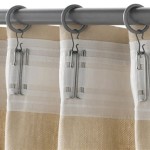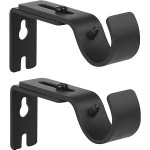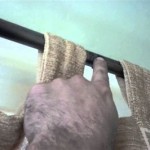How to Hang Dorm Curtains Without Nails
Dorm rooms often present a unique challenge when it comes to personalization. Restrictions on permanent modifications, such as using nails or screws, are common to prevent damage to the walls. This necessitates creative and non-destructive methods for hanging decorations, particularly curtains, which can significantly impact the ambiance and privacy of the space. Successfully hanging curtains without nails requires careful planning and the selection of appropriate materials.
The aesthetic and functional benefits of curtains in a dorm room are manifold. They can offer privacy, block out unwanted light for better sleep, add a personal touch to an otherwise sterile environment, and even help insulate the room, contributing to temperature regulation. However, achieving these benefits without violating dorm rules requires embracing alternative hanging techniques. Several methods exist, each with its own advantages and disadvantages, and the suitability of each will depend on factors such as the weight of the curtains, the type of wall surface, and the budget. This article outlines some common and effective methods for hanging dorm curtains without the use of nails.
Utilizing Tension Rods
Tension rods are a popular and straightforward solution for hanging curtains without nails, particularly in window recesses or between parallel walls. They work by exerting outward pressure against the surrounding surfaces. The rod is typically made of metal and contains an internal spring mechanism and rubber ends to provide grip and prevent slippage. Properly installed, a tension rod can support a considerable amount of weight, making it suitable for lightweight to medium-weight curtains.
The installation process is relatively simple. First, measure the distance between the two surfaces where the rod will be placed. Then, extend the tension rod slightly beyond this measurement, compressing the internal spring. Position the rod at the desired height and release the pressure, allowing the spring to expand and secure the rod in place. It is crucial to ensure the rod is level and firmly seated against the walls to prevent it from falling. Periodic checks and adjustments may be necessary, especially if the curtains are frequently opened and closed.
When selecting a tension rod, consider the weight of the curtains you intend to hang. Heavier curtains may require a sturdier rod with a larger diameter and a more robust spring mechanism. Also, pay attention to the finish of the rod. A non-slip coating on the rubber ends can improve grip and prevent damage to the wall surface. For wider windows or spaces, consider using a longer tension rod or two shorter rods joined together with a connector. However, be aware that longer tension rods may be more prone to sagging in the middle, especially with heavier curtains.
One potential drawback of tension rods is their limited aesthetic appeal. They are typically visible and may not blend seamlessly with the room's decor. To mitigate this, consider choosing a tension rod with a decorative finish or concealing it with a valance or other fabric treatment. Additionally, tension rods may not be suitable for all types of wall surfaces. Rough or textured walls may prevent the rubber ends from achieving a secure grip, while weak or damaged walls may not be able to withstand the outward pressure.
Employing Adhesive Hooks and Command Strips
Adhesive hooks and Command strips offer another versatile option for hanging dorm curtains without nails. These products utilize strong adhesive to attach to the wall surface, providing a secure anchor point for hanging curtains or curtain rods. They are readily available in various sizes and weight capacities, allowing for customization based on the specific needs of the project. The success of this method hinges on proper surface preparation and the selection of appropriate adhesive products.
Before applying adhesive hooks or Command strips, it is essential to thoroughly clean the wall surface with rubbing alcohol to remove any dirt, dust, or grease. This will ensure a strong and lasting bond between the adhesive and the wall. Follow the manufacturer's instructions carefully when applying the adhesive strips or hooks. Typically, this involves pressing the adhesive firmly against the wall for a specified period of time. Allow the adhesive to cure for the recommended duration before hanging the curtains to maximize its holding strength.
When choosing adhesive hooks or Command strips, select products that are specifically designed for the weight of your curtains. Overloading the adhesive can lead to failure and potential damage to the wall. It is generally advisable to err on the side of caution and choose hooks or strips with a higher weight capacity than necessary. Consider using multiple hooks or strips to distribute the weight more evenly, especially for heavier curtains or wider windows.
Several different types of adhesive hooks and Command strips are available, each with its own advantages and disadvantages. Some hooks are designed to be removable, allowing for easy repositioning or removal without damaging the wall. Others offer a more permanent bond, providing greater holding strength but potentially leaving residue or causing damage upon removal. Carefully consider the characteristics of each product before making a selection. Removable options are usually preferable in dorm settings.
One challenge with adhesive hooks and Command strips is their potential to damage the wall surface upon removal. To minimize this risk, use a hairdryer to gently heat the adhesive before attempting to remove the hooks or strips. This will soften the adhesive and make it easier to peel away from the wall without tearing the paint or wallpaper. If any residue remains, it can usually be removed with a mild solvent or adhesive remover. Despite this precaution, some minor damage may still occur, so it's important to consult the dorm's rules regarding wall repairs before proceeding.
Exploring Alternative Hanging Systems
Beyond tension rods and adhesive hooks, several other alternative hanging systems can be employed to hang dorm curtains without nails. These methods may require more ingenuity and customization, but they can offer unique solutions for challenging situations or specific aesthetic preferences. They can be particularly useful in situations where tension rods or adhesive hooks are not viable options, such as when dealing with uneven walls or unconventional window shapes.
One such alternative is to utilize a lightweight curtain rod supported by brackets that are clamped onto the window frame. These brackets typically feature rubber pads or protective coatings to prevent damage to the frame. The curtain rod is then suspended from the brackets, allowing for easy installation and removal without the need for nails or screws. This method is particularly well-suited for windows with deep frames or those that lack sufficient space for a tension rod. The weight capacity of the system relies on the strength and design of the clamping mechanism, which should be chosen appropriately for the weight of the curtains.
Another option is to create a makeshift curtain rod using a length of rope or wire stretched between two objects, such as coat hooks or existing fixtures. This method is highly adaptable and can be used to hang curtains in unconventional spaces. However, it requires careful planning and execution to ensure stability and safety. The rope or wire must be strong enough to support the weight of the curtains, and the anchor points must be secure and reliable. Eye hooks, carefully placed inside existing doorframes or mounted using removable adhesive, can provide secure anchor points.
For lightweight curtains, consider using magnetic curtain rods. These rods attach to metal surfaces using strong magnets, providing a quick and easy way to hang curtains on metal doors, window frames, or other magnetic surfaces. Magnetic curtain rods are particularly useful for creating privacy screens or room dividers in dorm rooms. However, they are not suitable for heavier curtains or surfaces that are not strongly magnetic. Always test the magnet's holding power before fully hanging the curtains.
Finally, consider using fabric tape or Velcro strips to attach curtains directly to the wall. This method is best suited for lightweight curtains and smooth, clean wall surfaces. Apply the fabric tape or Velcro strips to both the curtain and the wall, ensuring proper alignment and adhesion. This approach can create a streamlined and minimalist look. However, be aware that removing the tape or strips may require careful peeling and could potentially damage the wall surface. Test in an inconspicuous spot first.

How To Hang Curtains In A Dorm

5 Easy Ways To Hang Curtains Without Drilling

How To Hang Curtains Using Command Hooks The Happier Homemaker

How To Create Privacy Around Dorm Room Bed Simply Staged Llc

Make Dorm Apartment Privacy Curtains Quick N Easy For 10

How To Hang Curtains In A Dorm Room 6 Easy Methods

5 Easy Ways To Hang Curtains Without Drilling

4 Ways To Hang Curtains Without Tools Nails Or Holes Er Friendly Ft Command Curtain Hooks

5 Easy Ways To Hang Curtains Without Drilling

18 Surprisingly Useful Dorm Decorating S
See Also








